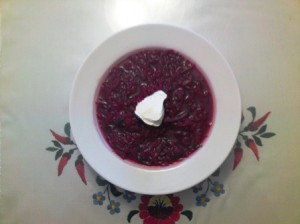In Memory’s Kitchen
A Legacy from the Women of Terezín
“When first I opened the copybook and saw the handwriting of my mother, I had to close it,” said Anny. “I put it away and only much later did I have the courage to look. My husband and I, we were afraid of it. It was something holy. After all of those years, it was like her hand was reaching out to me from long ago. . . . By sharing these recipes, I am honoring the thoughts of my mother and the others that somewhere and somehow, there must be a better world to live in.”On Yom Kippur in 1944, while a prisoner of Nazi Germany, in Terezín, Mina Pachter died of hunger. She had been many things, including a wife, mother, grandmother, student of art and literature, art dealer, and historian, before becoming a prisoner, cookbook author and keeper of memory.
Of the 144,000 Jews that were sent to Terezín, 33,000 died in the camp, 88,000 were deported to Auschwitz, and 19,000 survived. Only 100 children, of the 15,000 sent to Terezín survived. Terezín was different from other camps, in that the Nazi’s established it as a “model” for the world to see how well the Jews were being treated. When the Red Cross famously toured the camp, they were treated to a forced “performance” by the prisoners, who behaved as if they had their basic needs met. The Nazi’s spent five months preparing the camp for the Red Cross tour, and then all of those Jews who were forced to participate in the propaganda were immediately shipped to Auschwitz, once the international visitors left.
At Terezín a group of Jewish people were forced to administer the camps affairs. The camp never had enough food for all of its occupants, thus they decided to ration food according to expected survival rate. Children, who represented hope for a future, were given larger food rations, as were people who had physically demanding jobs, while senior citizens, who the administrators did not believe would survive the ordeal, were actually given much smaller portions of food. Thus many older people spent their time at Terezín searching and begging for food, with too many dying of starvation, like Mina Pachter.
Despite the most unimaginable circumstances, Mina Pachter chose to leave her daughter and by extension the world, a legacy of her history and tradition through a hand written cookbook. The book is a collection of not only her recipes, but of other women in the camp. The recipes were collected and sewn together into a book, which Mina Pachter treasured and protected, until she realized that her life was coming to an end. At that time, she gave the cookbook to a friend, Arthur Buxbaum, and asked if he survived to make sure that her daughter Anny, who had escaped to Palestine, was given the book. It took twenty-five years for the man to fulfill his promise; but the book eventually landed in Anny’s hands.
I placed this book with my other cookbooks, though it certainly could be with my Middle East books, as the story of the book and its creators matter as much as the recipes, many of which are incomplete, as they were written in the most deplorable of circumstances, by women who were suffering the effects of starvation and disease.
It was not uncommon for women, from this time period, to collect recipes and make their own cookbooks. The books were a way of keeping track of their cookery secrets, acquired knowledge, and of ensuring that their daughters or daughters-in-law would know exactly how to make millet dumplings, flaky strudel, goulash with noodles, or chicken galantine. However, to have spent so much of the precious life they had left, writing down recipes, while they starved, was truly an act of defiance and strength.
I love cookbooks, especially used cookbooks. As I have said before, I often buy used books – in fact, in most cases I prefer used books, as I feel that I am giving a lost book a home. I love finding other peoples notations, bookmarks, hand written letters, and sometimes even pictures. I always pause to notice people’s names or addresses, and think about how far the books have journeyed to find their way to me. With cookbooks, there is the added gift of other people’s recipes. Notes made on the covers, or recipes cut out from magazines, newspapers, or off the back of packages. I especially love when people bother to tweak the recipe, and make note of the changes!
My copy of In Memory’s Kitchen, A Legacy from the Women of Terezín was purchased used, but it seems to be a new copy, lacking any of the common touches of a used book with a spine that was not cracked until it landed in my hands. However, holding this book and leafing through the pages most definitely feels like an old book, with a previous owner. The weight of the women, who compiled this book, and made it possible for me to read their words, is imprinted along with its recipes. This is a book worth reading, and with a little tweaking of your own, you may find one or two recipes you too will want to make. That is all for now.











